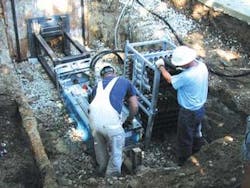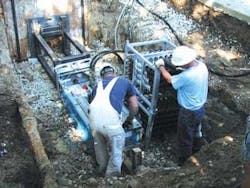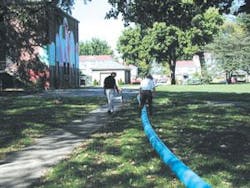Trenchless pipe bursting helps upgrade Louisville water mains
The Grundoburst hydraulic buster with patented QuickLock rods from Tracto-Technik of Lennestadt, Germany, is gaining attention from water utilities as a cost-effective method to upgrade and rehabilitate water mains.
The US city of Louisville, Kentucky, is taking an aggressive approach to upgrade and replace deteriorating water mains by using the trenchless pipe bursting method.
The city's water system, operated by the Louisville Water Company (LWC), consists of more than 5,150 km of water mains and handles 480 million litres of water per day. Louisville Water serves more than 900,000 people through its 240,000 domestic, commercial industrial, retail and wholesale customer accounts.
The majority of the cast iron system targeted for replacement was installed before and during the 1930s. The LWC has been systematically replacing these deteriorating water mains for more than two decades. The utility has turned to pneumatic pipe bursting as one solution to its problem. The method enables the city to replace aging sewer mains effectively and efficiently while minimising social disruption and lowering restoration costs.
The Louisville Water Company's main replacement and rehabilitation program (MRRP) targets approximately 40.25 km of pipe annually for replacement or rehabilitation. Officials outline projects for the program that will take place over a two-year period. Projects are selected based on a pipe evaluation model (PEM).
LWC Program Manager Keith Coombs explained: "The PEM is set up to look at 23 different criteria, grouped in four different categories. They include geography and location, hydraulics, maintenance, which encompasses break history, and quality of service. By evaluating mains based on the different criteria in each category we determine which mains are good candidates for replacement."
Beginning in 1976 with a modest budget of US$ 200,000, the program has grown to a budget of more than US$ 8 million, representing approximately 15% of the annual capital improvement budget. While much of the replacement that is done is completed through traditional open-cut methods, the LWC is always looking for new and more efficient methods of construction. Trenchless technology, specifically trenchless pipe bursting, is one method that has gained favour with the water utility.
Cast iron pipe replaced
LWC in-house crews recently replaced 274 m of cast iron pipe with an inside diameter (ID) of 150-mm with a 200-mm HDPE through static pipe bursting. Trenchless equipment manufacturer Tracto-Technik and its sister company TT Technologies from Aurora, Illinois, USA, provided technical support to the project, which was subdivided into two sections.
The first 122-m section of cast iron (ID 150 mm) main lay under a local park. The second section of approximately 152 m is located under a frequently travelled roadway. The crews placed a 400G Grundoburst static pipe bursting system in the exit pit at the end of the first run. After installing the bursting rods, the crew pulled back the bladed rollers and 122 m of the inside diameter (OD) 200-mm HDPE, replacing the existing cast iron pipe ID 150 mm.
For the second burst, the static machine was positioned in the exit pit at the end of the second run. Bursting times for this section, in addition to other sections, generally ranged between two and three hours.
Bursting was a good option for this project and crews took to the method well, according to Coombs. He said, "The location of the project made the pipe bursting method particularly attractive. We were not interested in trenching through the park and open cutting the roadway would have created many problems with traffic and congestion. With a minimal amount of training and some technical support our crews were able to get a handle on the bursting method quickly. The results were very positive."
Author's Note
Carola Schmidt is the export manager of Tracto-Technik GmbH Spezialmaschinen, based in Lennestadt, Germany. For more information, visit the website: www.tracto-technik.de.


